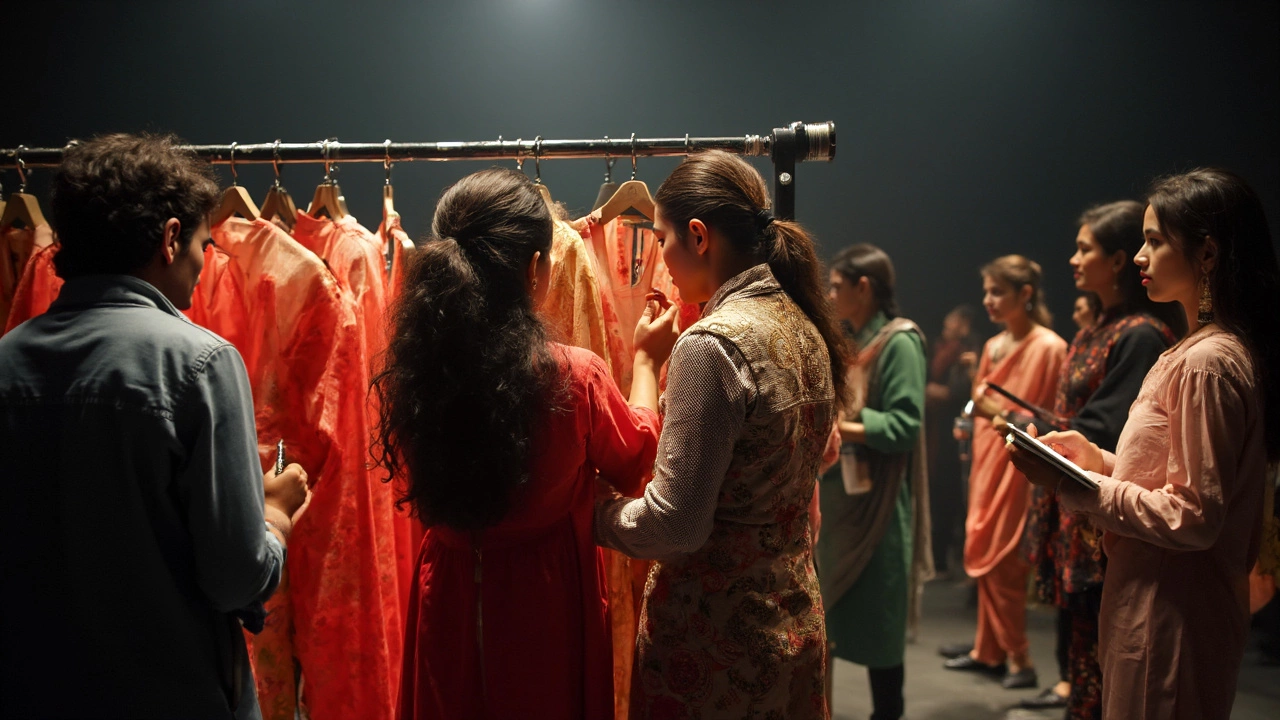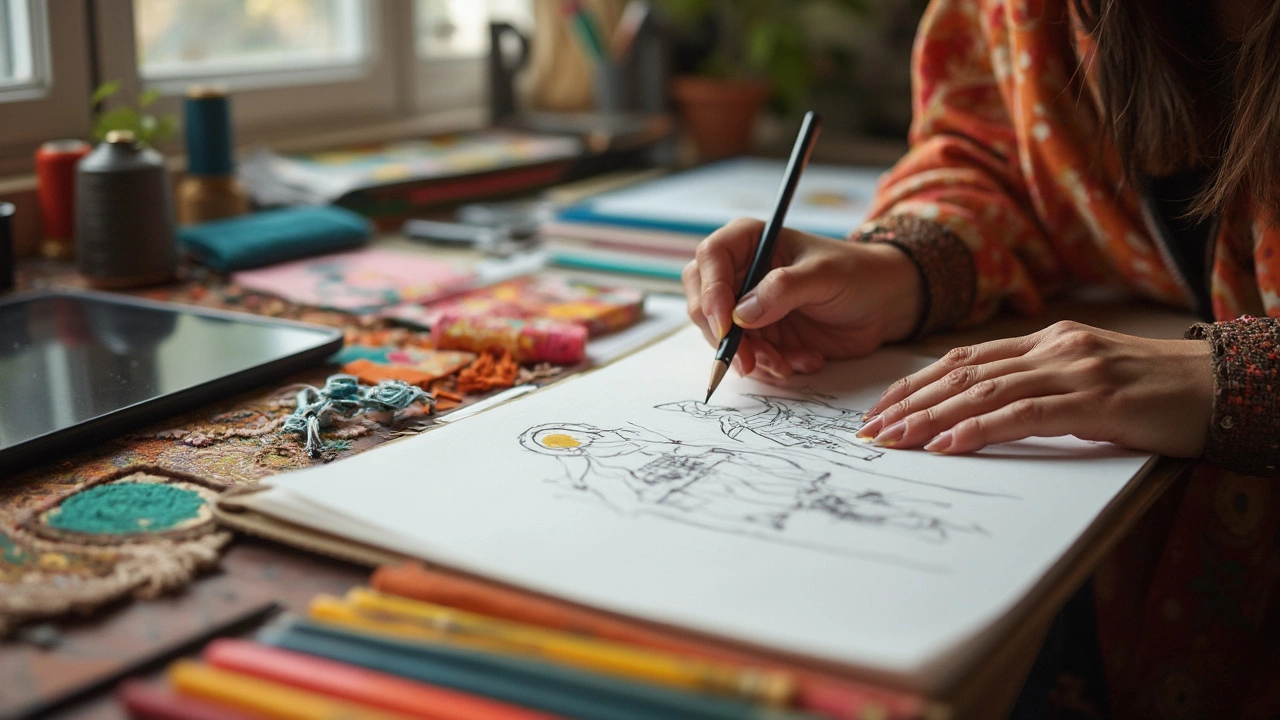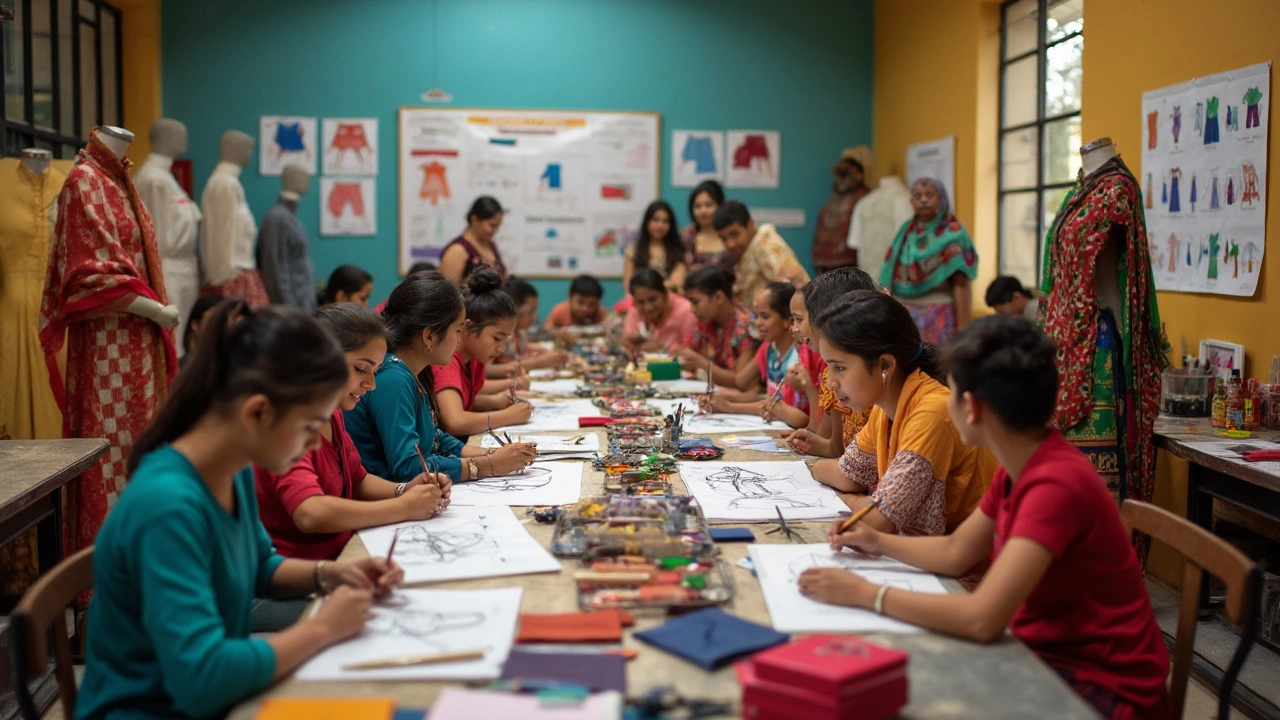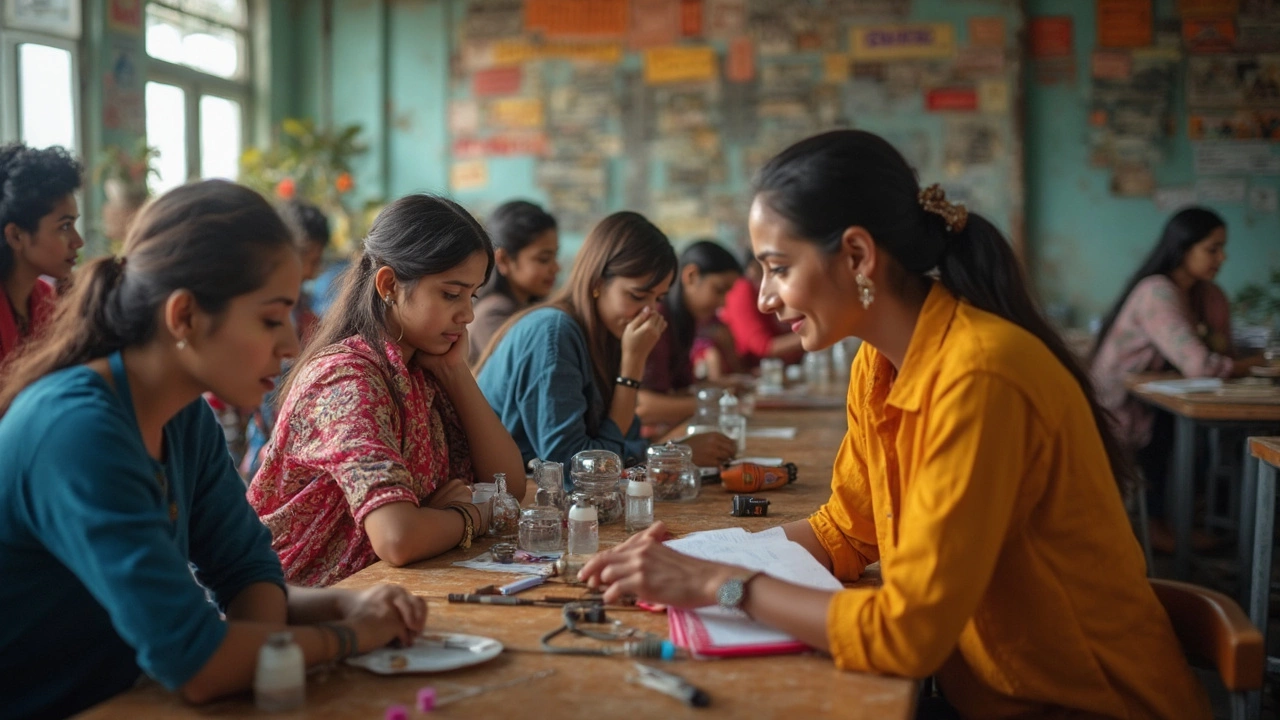People always think fashion designers live in a world of runway glitz, but there’s way more behind the scenes—actual stuff you have to learn. Want to make it in fashion? You need to study subjects that sound a bit boring but matter like crazy: design basics, textile science, pattern making, and even business subjects. It’s not just about drawing pretty dresses; you need to know how to turn an idea into something you can literally wear.
And here’s the kicker: every fashion design course kicks off with the basics, even if you already sketch like a boss. You’ll pick up how to choose the right fabric, the construction process (think: how seams and zippers actually work), and how to tell if your design will last after a couple of washes. You’ll also dive into color theory, so you know how to make those shades pop instead of clash. It’s all practical, hands-on stuff—there’s no shortcut here.
- The Basics: Core Subjects in Fashion Design
- Learning the Process: Sketch to Runway
- Why History and Trends Matter
- Skills You Can't Ignore: Tech and Communication
- Tips for Aspiring Designers
The Basics: Core Subjects in Fashion Design
If you want to become a fashion designer, you can’t skip the basics. First up, most fashion designing courses cover drawing and sketching. You’ll learn how to get your concepts out of your brain and onto paper, even if your art isn’t Instagram-worthy at first. Schools usually make you carry a sketchbook everywhere—seriously, everywhere—because ideas can hit you when you least expect them.
Next is pattern making. This is less about high art and more about math and accuracy. You’ll use rulers, learn to measure bodies, and figure out how to turn a 2D sketch into a flat pattern. This is what tailors or factories will use to actually build your clothes, so getting the angles right matters a lot.
Textile science comes in early, too. You can’t design if you don’t get how fabrics behave. Is that cotton going to drape, or is it going to stick out? Will it shrink in the wash? Most courses make you touch, stretch, and even burn fabric samples to see how different materials respond. It’s nerdy, but it saves a ton of hassle later on.
Garment construction is where it all comes together. This means learning how to sew properly, both by hand and with a machine. Most beginners mess up a ton of seams before things start looking wearable, and that’s totally normal. Expect your fingers to hurt, but also expect some major pride when your first piece is done right.
Last, you get an intro to fashion illustration and digital tools. No designer only uses pencils now—you’ll tackle software like Adobe Illustrator or Clo3D. Most top schools throw this into the first year because the industry expects you to be quick with tech as well as with your hands.
- Drawing and sketching fashion ideas
- Pattern making and fitting
- Textile science: learning about fabrics and materials
- Garment construction: sewing and assembling pieces
- Fashion illustration and digital design tools
Getting a grip on these basics is like learning to cook before you run a restaurant—you can’t skip them if you want things to work in real life.
Learning the Process: Sketch to Runway
So, how do you move from rough doodle to an actual outfit strutting down a runway? In a fashion designer course, you break this down into steps, each one more hands-on than the last. First off, you sketch—this is where your ideas start taking shape. Most programs start with classic pencil-and-paper skills, but digital sketching on tablets is getting just as common. Pro tip: apps like Procreate and Adobe Illustrator are big in the industry.
Once you’ve nailed the sketch, it’s all about bringing your design to life. Here’s a quick list of main steps you’ll go through during your studies:
- Concept development: Turn a small idea or mood into a clear theme for a collection.
- Fabric selection: Dig into fabrics—how they look, feel, and move matter a ton. A stiff cotton and a drapey silk will make the same dress look totally different.
- Pattern making: Think of this like the blueprint for your design. You learn to create, cut, and adjust patterns so clothes fit real humans (not just mannequins).
- Sewing and garment construction: This is where your fingers get to work. You’ll learn hand stitching and how to use industrial sewing machines—no escaping these basics.
- Fittings and alterations: Real life is all about fixing mistakes. You’ll test out your pieces on models, see what doesn’t work, and tweak until it’s just right.
- Final presentation: Many courses make you put on a mini runway show or portfolio review at the end. It’s nerve-racking but gives you a taste of what pros do.
Here’s a cool real-world stat: Most design schools expect students to finish at least 3-5 complete outfits by graduation. Some institutes give 8 weeks per collection project so you really learn how long creating even one look can take from start to finish.
| Step | Time Spent |
|---|---|
| Ideation / Concept Sketches | 1 week |
| Fabric & Trim Selection | 2-3 days |
| Pattern Making | 1-2 weeks |
| Sewing & Construction | 3-4 weeks |
| Fittings & Alterations | 1 week |
| Final Presentation | Few days - 1 week |
The magic is in the process. What looks effortless on the runway is weeks (sometimes months) of thoughtful decisions and hands-on work. Every step you learn stacks up, so by the time you get to that final runway walk, you’ll know these clothes inside out.

Why History and Trends Matter
If you think fashion designers just guess what will look cool next season, think again. To be good at this job, you need to know what worked before—and why it still matters. History isn’t about memorizing old-school styles just for fun. It’s about seeing what sticks around, what flops, and what keeps coming back, like how bell-bottom jeans keep sneaking back into stores. For anyone eyeing a fashion designer career, this is non-negotiable knowledge.
Take Coco Chanel for example. She changed women’s fashion forever by dropping the corset and popularizing comfortable, simple styles in the 1920s. That move flipped the whole industry—if you don’t know the story behind it, it’s hard to get why ‘timeless’ looks matter even today. The Met Gala gets talked about every year not just because of who goes, but because it highlights these moments in fashion history. Designers who nail it usually give a nod to the past in their new stuff.
Keeping up with trends is another must-have skill. Fashion is quick—blink and you miss what’s popular. According to a 2024 survey by the Fashion Institute of Technology, 87% of fashion pros say trend analysis is something they use all the time. That means you’ll be trained to spot shifts in what people wear, how social media sparks microtrends overnight, and when to drop your own spin before everyone else jumps in.
"Fashion is part of the daily air and it changes all the time, with all the events. You can even see the approaching of a revolution in clothes." — Diana Vreeland, former Vogue editor-in-chief
To keep you on the ball, most courses teach how past and current trends shape tomorrow’s styles. Check out this simple table to see how big events changed fashion forever:
| Historical Moment | Impact on Fashion |
|---|---|
| 1920s - Women’s Suffrage | Shorter skirts, flapper dresses, looser fits |
| 1970s - Disco Craze | Bell-bottom pants, glitter, bold patterns |
| 1990s - Grunge Movement | Ripped jeans, flannel, layered looks |
| 2020s - Social Media Boom | Microtrends, influencer-driven styles, fast fashion |
The tip here: dig into the history instead of skipping those textbook chapters. Noticing patterns and stories behind big changes gives your designs a deeper meaning and helps you predict where styles are headed. Plus, knowing these trends helps you avoid copying and instead, create something personal and fresh.
Skills You Can't Ignore: Tech and Communication
Every new fashion designer quickly finds out that tech skills aren’t just “nice to have” anymore—they’re expected. Most colleges train you on tools like Adobe Illustrator and Photoshop because hand sketches are cool, but brands want everything digital. Being able to use CAD (computer-aided design) means you can send patterns to manufacturers, whip up mockups for clients, and keep things moving fast. Some courses even use 3D fashion design apps, letting you test ideas virtually before anyone touches a fabric swatch.
But hold on—just knowing the tech side isn’t enough. You’ve got to communicate your ideas, too. Suppose you land an internship at a big design house; you’ll need to pitch your design to a bunch of people who may have their own strong opinions. They’ll want clear presentations, mood boards, and style sheets they can understand quickly. No one’s a mind reader, so being able to explain and defend your design is as crucial as designing itself.
Here’s a quick look at some must-have tech and communication skills, and how often they show up in real-world job listings:
| Skill | Need in Job Listings (%) | Where You Use It |
|---|---|---|
| Adobe Illustrator | 89% | Sketching, designing digital collections |
| CAD Software | 73% | Patterns, garment mockups |
| Public Speaking | 60% | Pitches, presentations |
| Team Communication Tools | 48% | Team projects, feedback loops |
If you feel lost about tech stuff, try short online courses—even YouTube has gold. And for communication, practice with friends: have them poke holes in your design explanations so you can sharpen up before facing actual clients or teams. A lot of people think “designing” means locking yourself away with a sketchpad, but honestly, the most successful designers are solid at teamwork and tech. If you nail both, you’ll have a serious advantage out there.

Tips for Aspiring Designers
Want to break into the world of fashion designer? It’s less about having some magical gift and more about using your time smartly. Here are some things I wish someone told me before I saw my first failed seam:
- Build Your Portfolio Early: Start collecting your work, even small sketches or rough prototypes. Fashion schools and employers want to see your creativity, not just finished stuff. Add photos, digital designs, and even failed attempts—you’ll be asked to talk about how you improved.
- Learn to Handle Criticism: Teachers, classmates, and even online strangers aren’t shy about sharing opinions. Treat feedback like free advice instead of a personal attack.
- Network Like Crazy: Spin class, Instagram, even your local tailor—opportunities pop up in the weirdest places. Collaborate on small projects and connect with people in the industry. The right introduction can open more doors than a perfectly sewn hem.
- Practice Technical Skills: Drawing is just a start. Pattern-making, draping, and sewing are a must. If you can’t sew, grab a basic sewing kit and try making a tote bag. You’ll mess up at first, but that hands-on practice is gold.
- Stay Updated: Fashion doesn’t stand still. Follow brands, designers, and trend reports. Platforms like Vogue Business and WGSN post trend forecasts you can actually use.
As Anna Wintour once said,
"You are nothing, nothing, without a good team and good mentorship. Be hungry, be curious, be willing to learn from anyone."
If you’re serious about this, don’t just daydream—start doing. Real progress comes from messing around with fabric, sharing your work, and talking to people who get the grind.


